
A Week of Extreme Weather In October
Hello friends,
October is usually a tumultuous month for us here in Dunedin, with the weather swinging in extremes from hot north westerly gales, to cold southerly fronts, including the threat of possible snow and frost, and this October was definitely no different from previous years regarding this.
In the third week of October we were warned of a spring north westerly wind storm approaching, and the resulting weather watches and orange wind warnings from Metservice had me worried.

In preparing for the north westerly wind storm, it first meant picking up anything outside that could go airborne, including my frost protection buckets (I lost one in the wind, but I eventually found it days later), taking down our bird feeders, moving our patio furniture to a more protected spot, putting our wheelie bins into the woodshed, and tying the glasshouse doors shut as they face the North West.


I also took the precaution of moving my most precious plants out of the glasshouse and into the garage for extra protection. I just couldn't risk losing our tomato plants, and dahlias in pots due to something unforeseen happening, like our glasshouse blowing away.
The big north westerly wind storm itself was frightening, and our house shook and shuddered for hours, first with the North Westerly gales, and then the Southerly front behind it, which took out our grid power for 8 hours. Luckily, we have solar panels on our roof, and a solar battery in our garage, and this system kept our house powered during the blackout (our battery has a storm watch function, and as soon as Metservice sent out the orange wind warning, the system began charging the battery to 100%). We are now very glad we invested in a solar system a couple of years ago.


All around Dunedin mature trees were blown over, trampolines went flying, fences were blown over, and the roofs of houses were lifted off. Many people in the lower South Island lost power for hours, and some for days, and even weeks.
Unfortunately, there were two casualties in my garden from the north westerly wind storm. My Avalanche camellia in the backyard garden snapped off at its base, killing the plant. It was only a year old, and didn't have a thick trunk yet, and it looks like it bent over in the wind until it just snapped. The only good thing about this happening is that it has given me one extra spot to plant a dahlia in this summer, but I am sad that I lost a beloved plant...
And the second casualty, was that my quince tree lost two north west facing tree limbs. They snapped partially off, so I had to trim them back to the nearest healthy branch on the tree. My quince tree is only 3 years old, so it won't suffer from losing a couple of young tree limbs. Thankfully the quince fruit forming on the tree didn't fall off during the storm.


With the north westerly wind storm over, it was time to clean up the garden of plant debris, reinstate our garden furniture to the patio, return the bird feeders to their rightful places, and transfer my precious plants sheltering in our garage back to the glasshouse.
The weekend after the north westerly wind storm was Labour Weekend, the traditional time to plant everything out in the vegetable and main gardens, but I was wary of doing this because Metservice forecast a cold southerly system occurring, with the potential of snow to low levels, and a frost afterward. I refused to risk planting out all my plants into the garden that weekend, only to have to frost cloth them for nights afterward.
So instead of spending the entire Labour weekend out in the garden planting out everything, my plants stayed safely inside the glasshouse where it was definitely warmer than outside, and I watched as the cold weather arrived...
And thank goodness I listened to the Metservice forecast, because the predicted low level snow fell, and settled to about 200 m above sea level in the hills surrounding us, and our temperature dropped to 1.1˚C overnight.


The dahlias growing outside were protected by their frost protection buckets, and all the plants in the glasshouse was protected by a number of layers of frost cloth. After a couple of days the weather warmed up back to early November temperatures, and it was time to plant stuff out in the garden, but it adds to my growing evidence that late October/early November is a risk to my Labour weekend gardening plans.
Have a wonderful day
Julie-Ann
Want to discuss my post? Feel free to chat with me on Instagram or Mastodon or Bluesky.
Making Citrus Frost Cloth Covers
Hello friends,
After buying a frost cloth cover from one of our local garden centres back in May, I wanted to make bigger versions for my three citrus plants before winter arrived.
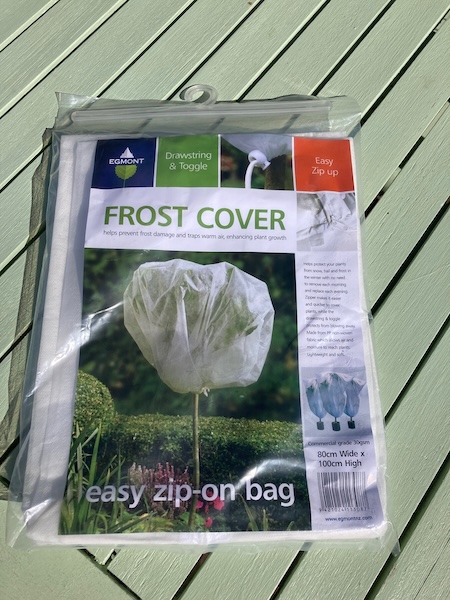
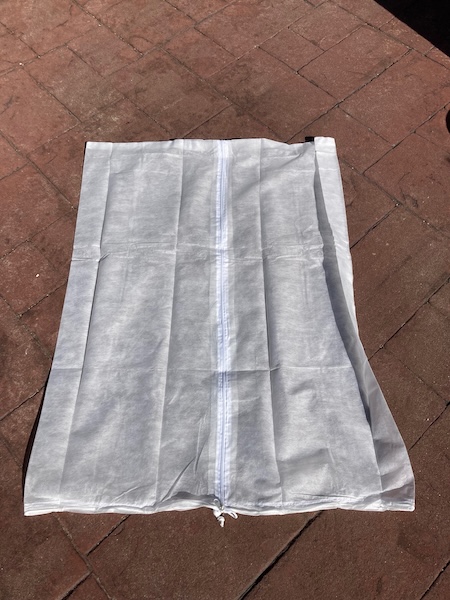
Luckily I had some very thick frost cloth in storage from last year, so I tracked it down and then got to work. The frost cloth was 2 metres wide and many metres long, so I used the width of the frost cloth as the height for each frost cover. I wrapped the frost cloth length around each citrus plant, added extra space for wiggle room to fit it over the citrus plants, and then marked it out on the frost cloth. I decided that adding a zip was just extra work, and more expensive, so I didn't bother with it.
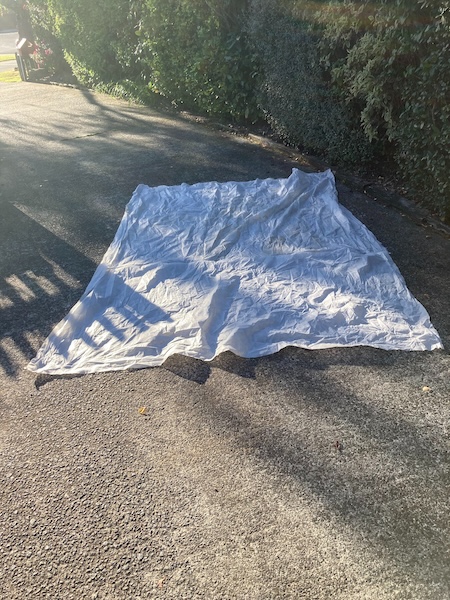
Once I had measured each plant, I went up to my craft room and cut off a length of frost cloth for each frost cloth cover. I then folded each section of frost cloth width wise, so that the width of the frost cloth formed the sides of the frost cover. The length of frost cloth that was folded in half then formed the top and bottom of the frost cover. With this done, I sowed along the top and the side of the frost cover. The bottom of the frost cover was left open for making the casing for the pull string, and to pull over the citrus plants when the frost cover was finished. I used a normal straight stitch on the sewing machine, and made sure the ends were well tacked down.
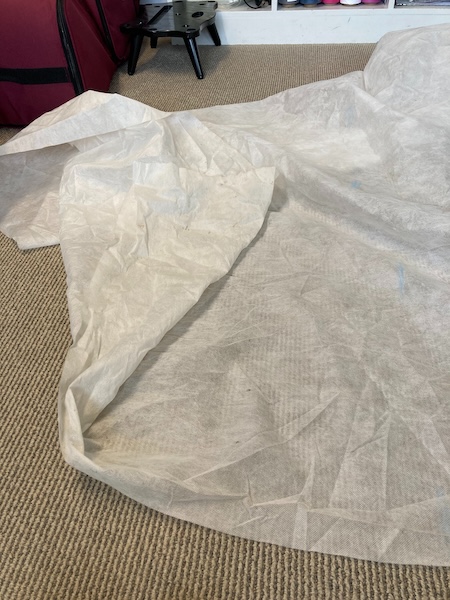
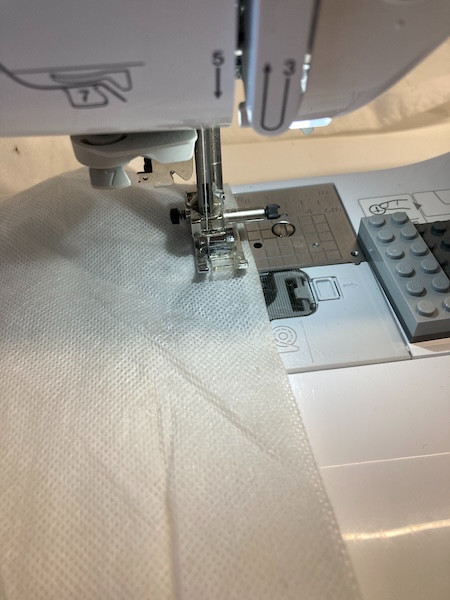
The next step was to sew a casing in the bottom of the frost cover, leaving a small opening so I could insert some nylon rope in a circle around the bottom. I purchased some general purpose nylon rope from Mitre 10, and some cord pullers from Spotlight.
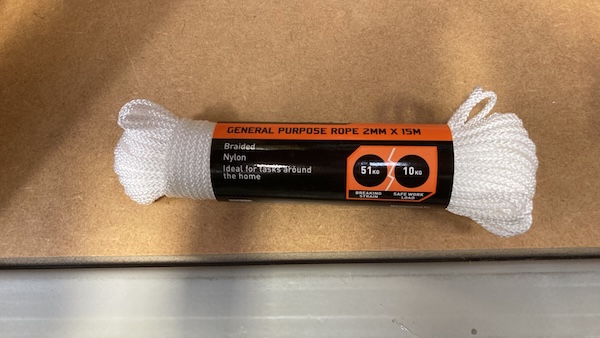
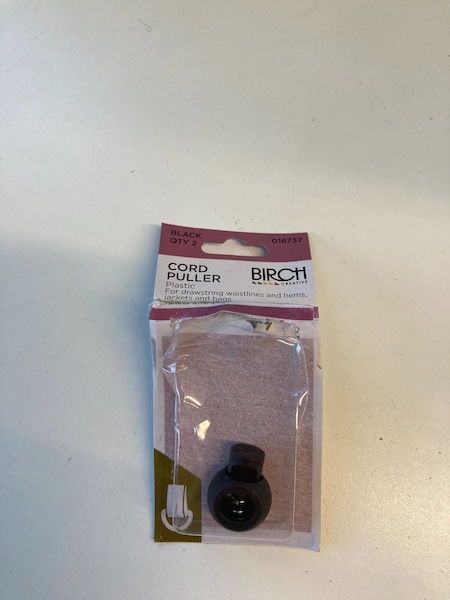
After sewing the casing, it was time to unwind the general purpose rope, and insert it into the casing. This was when Rosie cat came to assist me, and she helped me add the rope and the cord pullers to all three citrus frost covers.
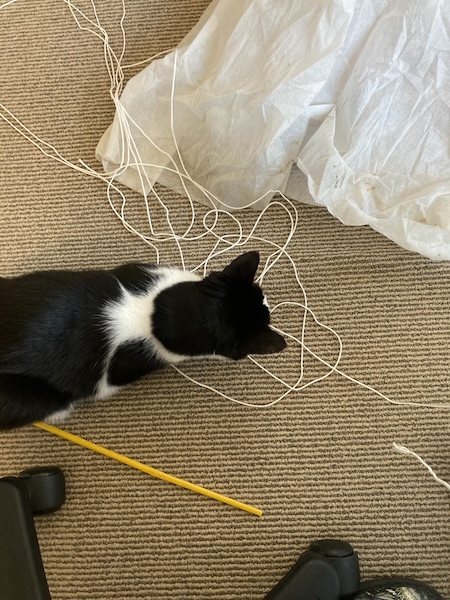
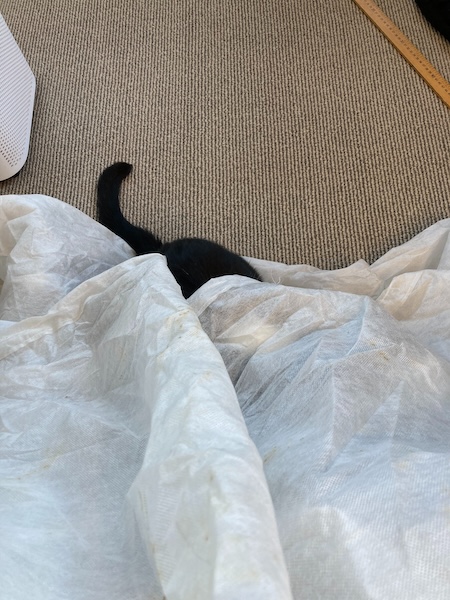
After making sure the cord pullers all worked, and tying the ends of the rope tight together, the frost covers were ready. After trying on each frost cover to the corresponding citrus plant, I labelled each one with a permanent marker.
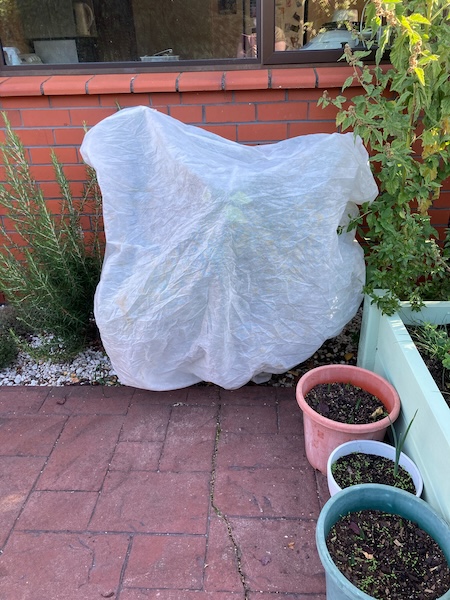
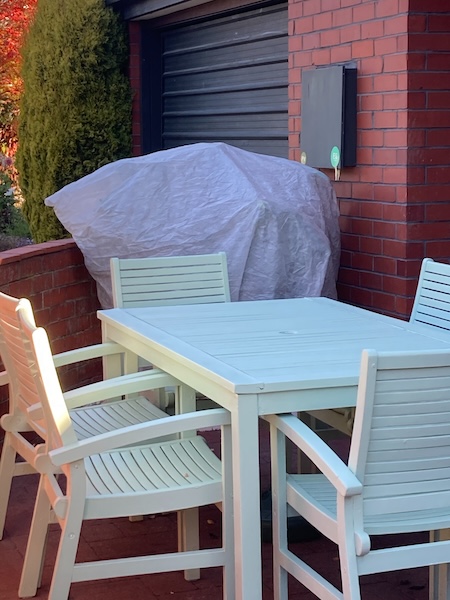
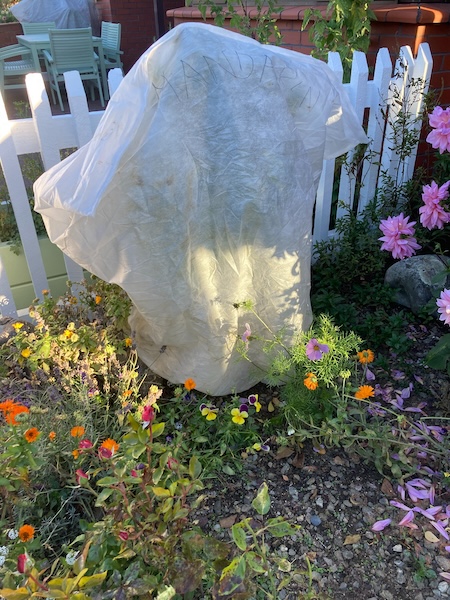
It's now winter, and we've had multiple frosts now. The frost covers have been such an asset to have, as they are so easy to pull on and off. It's really been so much easier to protect my precious citrus plants from frost and snow. And to make the frost covers myself, it was just a crafty bonus.
Have a wonderful day
Julie-Ann
Want to discuss my post? Feel free to chat with me on Instagram or Mastodon or Bluesky.
Outdoor Citrus Frost Cloth Project
Hello friends,
Sometimes it's just easier to buy stuff you need for the garden, and especially when the task you need to complete takes up a lot of time.
We were in the local garden center the other day and spied a new product on the shelves. Egmont is now selling a frost cover with a drawstring and toggle, and the frost cover is zipped on for easy placement and removal. The frost cloth is commercial grade, and the fabric is 30 gsm. I didn't buy one at the time because the bag is only 80 cm wide by 100 cm tall. The bag wouldn't be big enough to fit any of my citrus plants.
But after thinking about it over the Easter weekend, the bag would be big enough to use as a template to make larger versions that would fit my citrus plants. I went out and bought one after Easter, and it was only $10, which is a pretty good deal considering how big the zip is.
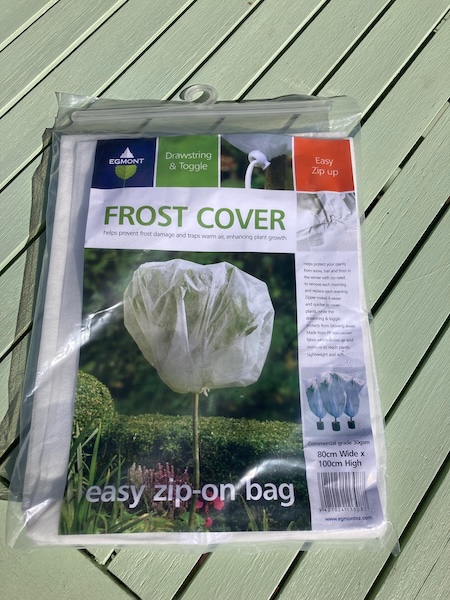
As you can see from the photos the frost cover bag is a rectangle which has been folded in two halves with a zip down the middle. The top is sewn across with a heavy seam which won't rip easily. The bottom contains a fabric casing to hold a thick cord, which is held in place by a strong toggle.
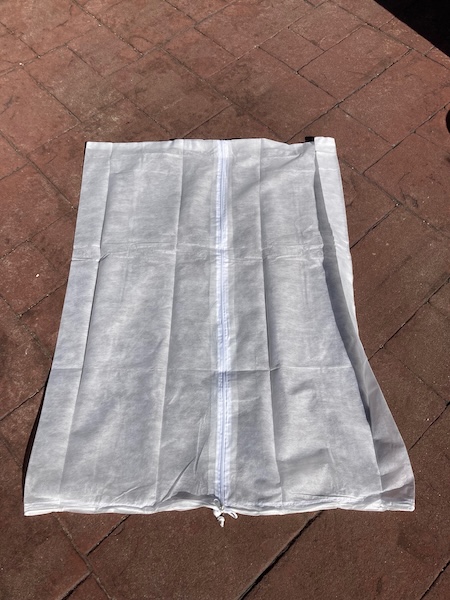
I tried placing the frost cover over the smallest citrus plant I have, which is our mandarin bush, and as you can see it is pretty squished inside the frost cover. It definitely needs more space so that the branches don't get squished. But the frost cover was pretty easy to put on, and the thick cord and the toggle did a great job of keeping the frost cover in place.
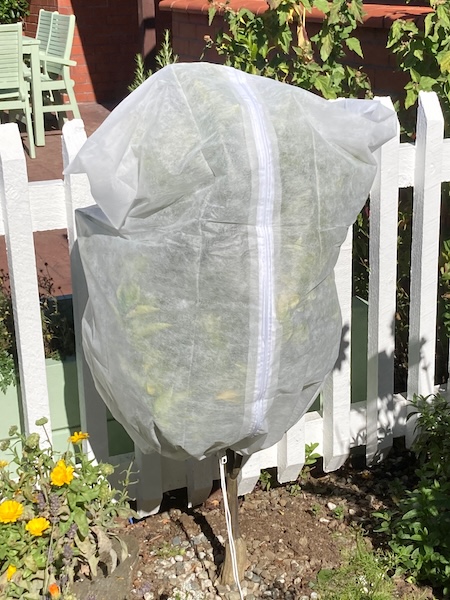
So even though I can't use this frost cover to protect my citrus plants, I can use it as a template to make bigger versions that I can use. And afterward I can use this frost cover for my small Camellia sinensis tea plant over winter, so that is a good bonus for me. In the coming weeks I'll make up the template for the citrus plants, and build a trial one for testing.
I did ask the garden center if Egmont planned on making bigger versions, but she said that this product had only just come onto market, so not likely this year. They were going to pass on my suggestion for Egmont make bigger versions in the future.
My suggestion is if you do have smaller citrus plants, that the Egmont frost cover is definitely worth buying for your plants over the coming cold season. With it being easy to take on and off, it'll save you time and protect your precious plants from any frosts that do happen.
I just need to now pull out all my current frost cloth stash and see if I have any frost cloth that can be used for making some bigger covers for my own plants.
Have a wonderful day
Julie-Ann
Want to discuss my post? Feel free to chat with me on Instagram or Mastodon or Bluesky.
Our Weather Station, and Our 2023 Weather Data
Hello friends,
With it now being the new year, I can now share the 2023 weather data from our home weather station. I like to track the weather each year, so I'm aware of trends like first and last frost date, snow, and also how much rainfall we're getting.
Up until March last year, I had been using nearby weather stations for our data, but when the two closest weather stations shut down, it was time to once again invest in a weather station of our own. We had a weather station when we lived in Wellington, but my husband accidentally smashed it when he chopped down a tree on our property (I did suggest before he chopped the tree down that we should move the weather station out of the way, but he said it would be fine...).
After much research last year we chose the Ecowitt GW1101 WIFI weather station, which has a 7-in-1 Outdoor Sensor Array: (wind vane, wind cups, UV / solar
radiation sensor, thermo-hygrometer sensor, and rain gauge), and a USB Wi-Fi Gateway. The WIFI gateway lets you import your weather data in a number of ways, and we chose to import the data onto our local server, and hubby made a local web interface for looking at the data. We also chose to add on a number of other sensors to the WIFI gateway, so we also have four soil water sensors, and a PM 2.5 air quality sensor. We currently have one soil sensor in our glasshouse, and the other three under each citrus tree we have. The air quality sensor is installed between us and our neighbour who has a very smoky woodburner. We have also just purchased two water leak detection sensors to add to our system, as we got a leak in our roof space last week, and had water coming down from our garage ceiling. We're going to place the sensors near our old hot water cylinder, and also near the garage in the roof space as an early warning system for the future.
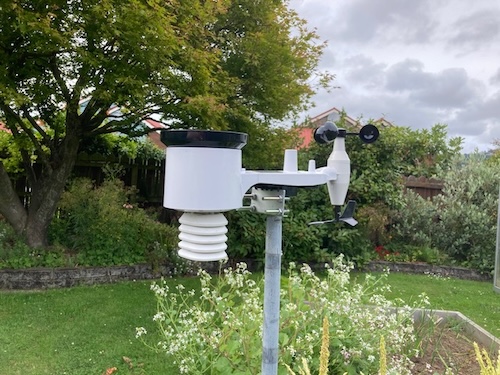
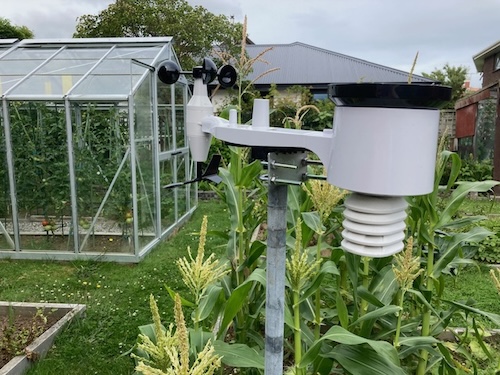
We positioned our weather station in one of our vegetable garden beds, as it was away from lots of heat sinks like the house and concrete paving, and we reused the pole from our old TV aerial to mount it in place.
In this blog post, I will be sharing the general weather data that was collected during the 2023 year.
Yearly Weather Totals:
Lowest Temperature of the Year: The lowest temperature for the year was -6.8˚C, which happened on the 8th of June 2023. This temperature occurred during a week of heavy frosts, we had 7 days of no wind and clear nights. This temperature happened on the third day of frosts in that week. This frost was responsible for killing one tree, as all the leaf buds had been heavily damaged. This cold weather led to very high PM2.5 air quality readings in all of Mosgiel, and we had to have two air filters running inside the house to keep the air clean.
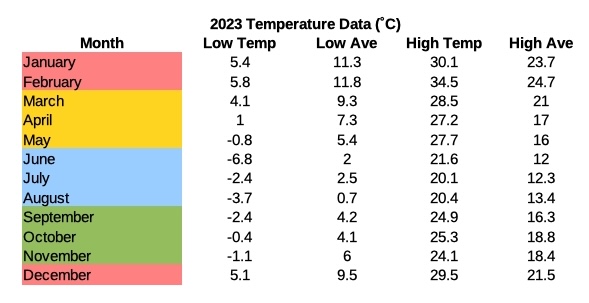
Highest Temperature of the Year: The highest temperature for the year was 34.5˚C, and this happened on the 2nd of February 2023. This happened on a summer day where we had strong North Westerly Foehn winds. This NWer Foehn wind set up is common in Dunedin before a Southerly arrives, and this can happen at any time of the year. NWers are common in winter just before a winter snow storm from Antarctica, so the temperature change can be quite drastic within a day.
Rainfall for the Year: This year we had a rainfall total of 931.4 mm rain. March was unexpectedly rainy, it's usually one of the driest months of the year in mid autumn. January 2023 was particularly sunny and dry, and we were on water restrictions until March.
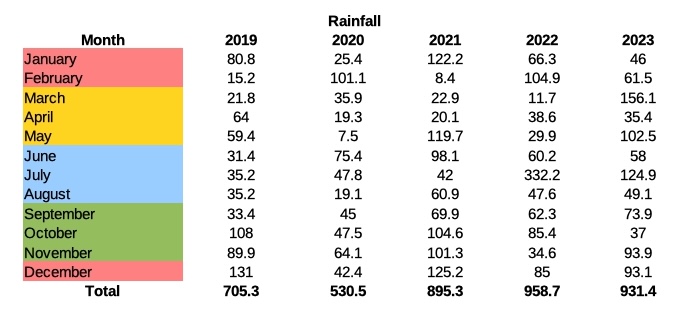
Frost Days: Here in Dunedin it's cold in winter, and we get a large number of frosts, which is good for killing off pathogens in the garden, and helping fruiting in trees and bushes like apricots, cherries, and blackcurrants. We had 38 frost days in 2023. The first frost was on 22 May 2023 and was -0.8˚C, and the last frost was on 10th November 2023 and was -1.1˚C. The last frost date was particularly terrible, as it was well past the date where it is assumed plants growing in the vegetable garden would be safe, and I lost many vegetable plants including beans and pumpkins. My grandad always told me it was safe to plant vegetable plants outside from Labour day weekend, and that's the date I use in planting frost tender plants. You can find an in depth blog post on the November frost here.
I've included other Frost Days in the years since we moved into our home. As you can see in general, the first frost is usually in May, and the last one in October. The last frost in November 2023 is an outlier.
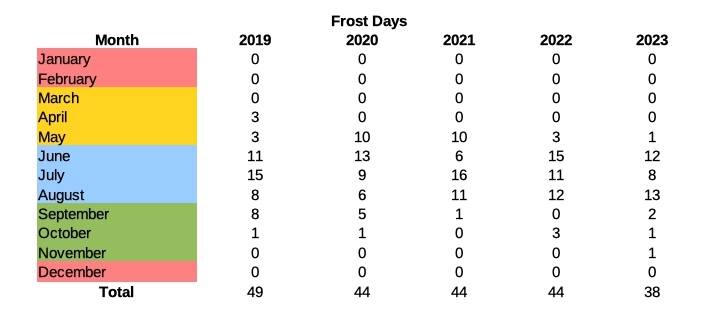
As another way of visualising the frosts in 2023, I've graphed out each instance of frost against time for 2023. There are distinct clumps of frost occurring throughout the year, and they usually happen after a southerly front has gone through.
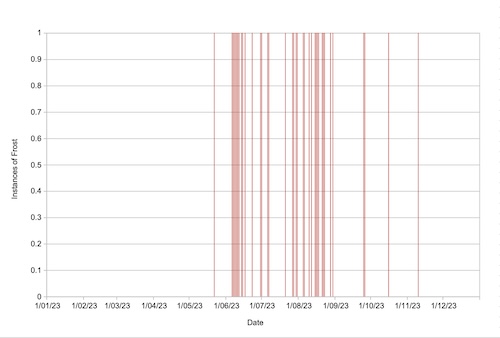
Snow Days: I count snow days as days that we have snow falling outside our home at our height above sea level (30 m), whether or not it may settle. Snow means that a big southerly storm has gone through, and this will lead to frosts afterward. In 2023, we had three snow days, two in July, and one in October. The one in October was very out of character, as usually we get snow events between July and September.

These are the most important factors I look at in interpreting the weather data, but there is much more I could look at, for example comparing frost and snow days verses days that NWers come in before a Southerly storm. 2024 will be the first year I will collect data on NW days.
Do you collect your own weather data for the year? I found it's very useful for in planning in the garden. There's lots of amateur weather stations available online to collect your own weather data, but if you're a big weather geek like me, it doesn't take long before deciding to get a weather station of your own.
Have a wonderful day.
Julie-Ann
Want to discuss my post? Feel free to chat with me on Instagram or Mastodon.




